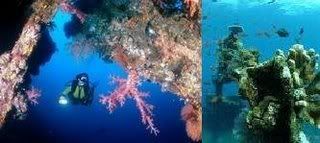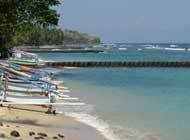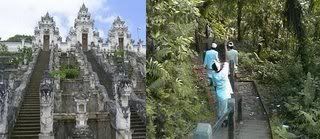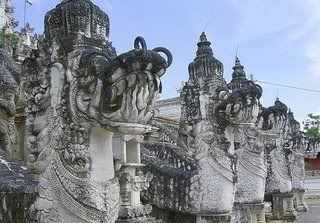| A small village on the north-east coast of Bali | |
| TYPE OF DIVE: | Shore Diving, Wreck-diving, Wall-diving, Night-diving, Deep-diving, photography (Batu Kelebit is a 5min outrigger journey from Tulamben) |
| VISIBILITY: | 12 - 25 metres |
| CURRENT: | Zero to mild currents |
| DEPTHS: | 3 - 40 metres (average depth 18 metres) |
| MIN LEVEL: | Introductory - suitable for every level and interest! |
| HIGHLIGHTS: | Extraordinary diversity of marinelife, huge school of Big-eyed Trevally. 120-metre shipwreck, beautifully coloured wall. Full Moon Night Dive. Great photographic opportunities and colour contrast with the black sand. AquaMarine's first choice for our special 1 Day Intro Adventure Diving Program. Great snorkelling site. |
| CONDITIONS: | Black sand slope with a 120-metre shipwreck, coral gardens and a wall. The fist-sized black stones can make entry tricky when there are waves present. |
 Tulamben
is the most famous area for diving in Bali and therefore where you are
more probable to the photographers and the writers internationally
recognized of the meeting. The bay of Tulamben, like the rest of Bali,
is located in richer the marine biogeografy zone of the world. Being in
the northeast coast, the bay have very rich plankton waters of the main
current of the ocean that moves from the Pacific to the Indian Ocean.
This, joined with the fact that the three main sites of the plunge
provide totally diverse physical atmospheres, means that Tulamben
contains an imposingly diverse underwater ecosystem. The beach is the
fist-classified black volcanic rocks that become sand in shallows. This
black sand does not provide the reflective characteristics of the
white sand like the limestone stone, combined with the amount of
plankton in the water, it does not explain the relatively low
visibility (12-25M). Nevertheless it provides a dramatic resistance,
that brings outside towards the colors of the chorales, gorgonians, the
fish and the other marine life. 100s of the macro-species that live
here mixes and puts wonderfully in resistance with the sand.Tulamben
is a wonderful place to learn to plunge themselves and to learn on
underwater life. There is sightings occasional of the Mola-Mola
(Sunfish), Manta rays, whale shark, the tuna and the other pelagic but
is the permanent population of Tulamben. The shipwreck of the freedom
of USAT the most famous site of the plunge of Bali. Circa constructed to
east WWI cargo vessel was equipped of the arms for WWII, torpedoed by
the Japanese of Lombok; in spite of attempts to tow the ship to North
Bali it took in too much water so it was beached in Tulamben. On the
years any re-usable thing was cleared. In 1963, with the land tremors
of the eruption passed of the Agung assembly, the ruin slipped more far
under the hill where still it lies (as near the beach as it can be and
still to be underwater). The freedom almost lies parallel coast
outside of approximately 30m to the beach in the hill of the sand and
is advisable for all the levels of the qualification and the experience.
The ruin lies in depths from 9-30m; the lowest part of the ruin, where
it touches the hill of the sand, is in 5-10m. The depth throughout the
center of the ruin is 16-20m. The edge more under the ruin, the future
plain the hill, is 20-28m (in the high tide). The ruin is 120m long,
he is broken enough upon (no penetration possible) but you can
immovable consider the arms, dressing tables, the boilers, the chain of
anchor, the etc. Is a charming site of the plunge, possibly the
easiest plunge of the ruin of the world. You also can tube respirator
in the ruin - the point upper of the stern is near 4m underneath the
surface. The visibility is generally 18-25m, low when there is been
raining. There is rarely a present present, at the most he will be
smooth. During the 3 days before the Full Moon, there are waves
generally. Temperature of the air is 25-32degrees, the water
26-28degrees. Trevally (cats), ruin of the freedom, Tulamben the ruin
is very popular between the photographers then encrusted totally in
anemone, gorgonia and chorales. The black sand provides an excellent
resistance of the color for the incredible variety of marinelife, that
includes an enormous school (literally 100s) of the fish of silver
10-12inch calls Great Trevally and on 400 other species of fish. All
the fish are very domestic (partly as resulting from some guides that
feed them, something a practice of the non environmentally sound of the
Goatfish and the Wrasse that mordiscan around your feet and fins
during exit door to the Unicornfish and to the Surgeonfish that make a
(that alarms the first time slightly to you to see them) beeline for
your mask as you swim down towards the ruin. It is absolutely difficult
to enumerate what you will see because you will see just mainly in any
tour guide Hindu-Pacific of Reef if you plunge yourself here. Of the
Anglerfish meticulous, nudibranches, the Pipefish of the ghost, the
neon systems of camarón/de goby, to traverse to the areas of the eels
of the garden and clouds multi-colored of anthias and damsels and
ignited to the schools of Sweetlips, Batfish, fusiliers, Butterfly
fish, the variety is amazing. Then there are the invertebrates, the
hard and smooth chorales, choral black, sponges with crinoids,
ventilators of the sea, tunicates. If you plunge early the first
snorkeling in the ruin (only possible if you remain during the night)
you can, you can, to see the turtle. It is the best hour to plunge the
ruin. The jump at night in the ruin is great specially during the Full
Moon. You can see Spanish dancers, fish of the lantern, fosforescencia.
The wall has profuse sponges, corals, black coral bushes, gorgonian
fans - at 30M there's one that reaches 2M in width that we visit for
the Deep Dive on Advanced Courses. The wall, the lava spur, then
reverts to being a steep slope.The
fish life is similar to that found on the wreck but being a much
larger area, is less dense. However, more often than on the Wreck, you
will see white tip reef shark, large Napoleon Wrasse, big Bumphead
Parrotfish, some big Filefish (including Scrawled), and large Moray Eel.
Late afternoon is the time to see the wide variety of Lionfish that
live here, I'm not the person to ask why we see so many of them! There
have been sightings of Whale Shark in as little as 9M of water, and
much deeper, Hammerhead Shark. The back reef at the top of the Wall,
averaging 5M, contains an excellent 'aquarium section', including
cuttlefish, octopus, boxer crabs and many other unexpected treasures,
enabling you to finish your dive at around 5m for pretty much as long
as you want to. This is, of course, also very popular with snorkelers.
The Coral Garden Blue Ribbon Eel, Tulamben Coral Garden Blue Ribbon Eel
Adult Female Rhinomuraena quaesita Running along the middle section of
Tulamben beach is a shallow reef (averaging 8-12m so also excellent
for snorkelling) of mainly table and fire corals interspersed with
anemones as well as barrel and other sponges. The fishlife, as with the
Drop-off and the Wreck, is very diverse. It is here that you can see a
surprising number of Blue Ribbon Eels (the juveniles are black) and
octopus, the variety of shrimp is surprising too along with the
different anemonfish. The bigger fish seen here are Bumphead Parrotfish
and Black Tip reef shark. The depth and location make the Coral Garden a
very good, and popular, Night Dive on which you may see Spanish
Dancers and flashlight fish. In fact the diving actually extends much
deeper than 12M, if you carry on down the sand slope, you'll find
barrel sponges with many surprises: juvenile Emperor Angelfish,
Two-spot Lionfish, maybe a school of juvenile catfish; cleaning
stations with shrimp and wrasse, a shoal of Razorfish swaying in their
hiding place. If you continue along the slope, towards the start of the
Drop-off, you'll come to a dry river bed, scooped out into a
bowl-shape, marked by ridges radiating outwards. These ridges are often
the best places in Tulamben to find unexpected specimens. Although it
is certainly not an area for divers looking for a profusion of
marinelife! Batu Kelebit (Kelebit Rocks) A 15 min. jukung (local
outrigger) ride east from Tulamben Bay will take you to these two large
rocks that lie just offshore. The dive site is quite dramatic and
consists of three steep ridges encrusted with an incredible diversity
of hard corals, beautiful sea fans, fire corals and sponges and between
these ridges are channels of white sand. Coleman Shrimp in Fire Urchin
Coleman Shrimp in Fire Urchin Periclimenes colemani In fact, it is not
only the colour of the sand that differs from Tulamben Bay, the
species of even the most common reef fish are different too. The marine
life varies from the tiny up to the very large: the steepness of the
site combined with the structure of the ridges (and plankton-rich
water) means you also have much more chance to see pelagics including
barracuda, tuna, manta and white tip reef shark here than you do within
the Bay. The diving here is colder than within Tulamben Bay and not
only because the diving here is generally deeper: there's a cold water
eddy that comes up from the depths. Visibility is generally as low as
15-20M due to the amount of plankton in the water. The current can be
quite strong at times but the channels are well-protected.
Tulamben
is the most famous area for diving in Bali and therefore where you are
more probable to the photographers and the writers internationally
recognized of the meeting. The bay of Tulamben, like the rest of Bali,
is located in richer the marine biogeografy zone of the world. Being in
the northeast coast, the bay have very rich plankton waters of the main
current of the ocean that moves from the Pacific to the Indian Ocean.
This, joined with the fact that the three main sites of the plunge
provide totally diverse physical atmospheres, means that Tulamben
contains an imposingly diverse underwater ecosystem. The beach is the
fist-classified black volcanic rocks that become sand in shallows. This
black sand does not provide the reflective characteristics of the
white sand like the limestone stone, combined with the amount of
plankton in the water, it does not explain the relatively low
visibility (12-25M). Nevertheless it provides a dramatic resistance,
that brings outside towards the colors of the chorales, gorgonians, the
fish and the other marine life. 100s of the macro-species that live
here mixes and puts wonderfully in resistance with the sand.Tulamben
is a wonderful place to learn to plunge themselves and to learn on
underwater life. There is sightings occasional of the Mola-Mola
(Sunfish), Manta rays, whale shark, the tuna and the other pelagic but
is the permanent population of Tulamben. The shipwreck of the freedom
of USAT the most famous site of the plunge of Bali. Circa constructed to
east WWI cargo vessel was equipped of the arms for WWII, torpedoed by
the Japanese of Lombok; in spite of attempts to tow the ship to North
Bali it took in too much water so it was beached in Tulamben. On the
years any re-usable thing was cleared. In 1963, with the land tremors
of the eruption passed of the Agung assembly, the ruin slipped more far
under the hill where still it lies (as near the beach as it can be and
still to be underwater). The freedom almost lies parallel coast
outside of approximately 30m to the beach in the hill of the sand and
is advisable for all the levels of the qualification and the experience.
The ruin lies in depths from 9-30m; the lowest part of the ruin, where
it touches the hill of the sand, is in 5-10m. The depth throughout the
center of the ruin is 16-20m. The edge more under the ruin, the future
plain the hill, is 20-28m (in the high tide). The ruin is 120m long,
he is broken enough upon (no penetration possible) but you can
immovable consider the arms, dressing tables, the boilers, the chain of
anchor, the etc. Is a charming site of the plunge, possibly the
easiest plunge of the ruin of the world. You also can tube respirator
in the ruin - the point upper of the stern is near 4m underneath the
surface. The visibility is generally 18-25m, low when there is been
raining. There is rarely a present present, at the most he will be
smooth. During the 3 days before the Full Moon, there are waves
generally. Temperature of the air is 25-32degrees, the water
26-28degrees. Trevally (cats), ruin of the freedom, Tulamben the ruin
is very popular between the photographers then encrusted totally in
anemone, gorgonia and chorales. The black sand provides an excellent
resistance of the color for the incredible variety of marinelife, that
includes an enormous school (literally 100s) of the fish of silver
10-12inch calls Great Trevally and on 400 other species of fish. All
the fish are very domestic (partly as resulting from some guides that
feed them, something a practice of the non environmentally sound of the
Goatfish and the Wrasse that mordiscan around your feet and fins
during exit door to the Unicornfish and to the Surgeonfish that make a
(that alarms the first time slightly to you to see them) beeline for
your mask as you swim down towards the ruin. It is absolutely difficult
to enumerate what you will see because you will see just mainly in any
tour guide Hindu-Pacific of Reef if you plunge yourself here. Of the
Anglerfish meticulous, nudibranches, the Pipefish of the ghost, the
neon systems of camarón/de goby, to traverse to the areas of the eels
of the garden and clouds multi-colored of anthias and damsels and
ignited to the schools of Sweetlips, Batfish, fusiliers, Butterfly
fish, the variety is amazing. Then there are the invertebrates, the
hard and smooth chorales, choral black, sponges with crinoids,
ventilators of the sea, tunicates. If you plunge early the first
snorkeling in the ruin (only possible if you remain during the night)
you can, you can, to see the turtle. It is the best hour to plunge the
ruin. The jump at night in the ruin is great specially during the Full
Moon. You can see Spanish dancers, fish of the lantern, fosforescencia.
The wall has profuse sponges, corals, black coral bushes, gorgonian
fans - at 30M there's one that reaches 2M in width that we visit for
the Deep Dive on Advanced Courses. The wall, the lava spur, then
reverts to being a steep slope.The
fish life is similar to that found on the wreck but being a much
larger area, is less dense. However, more often than on the Wreck, you
will see white tip reef shark, large Napoleon Wrasse, big Bumphead
Parrotfish, some big Filefish (including Scrawled), and large Moray Eel.
Late afternoon is the time to see the wide variety of Lionfish that
live here, I'm not the person to ask why we see so many of them! There
have been sightings of Whale Shark in as little as 9M of water, and
much deeper, Hammerhead Shark. The back reef at the top of the Wall,
averaging 5M, contains an excellent 'aquarium section', including
cuttlefish, octopus, boxer crabs and many other unexpected treasures,
enabling you to finish your dive at around 5m for pretty much as long
as you want to. This is, of course, also very popular with snorkelers.
The Coral Garden Blue Ribbon Eel, Tulamben Coral Garden Blue Ribbon Eel
Adult Female Rhinomuraena quaesita Running along the middle section of
Tulamben beach is a shallow reef (averaging 8-12m so also excellent
for snorkelling) of mainly table and fire corals interspersed with
anemones as well as barrel and other sponges. The fishlife, as with the
Drop-off and the Wreck, is very diverse. It is here that you can see a
surprising number of Blue Ribbon Eels (the juveniles are black) and
octopus, the variety of shrimp is surprising too along with the
different anemonfish. The bigger fish seen here are Bumphead Parrotfish
and Black Tip reef shark. The depth and location make the Coral Garden a
very good, and popular, Night Dive on which you may see Spanish
Dancers and flashlight fish. In fact the diving actually extends much
deeper than 12M, if you carry on down the sand slope, you'll find
barrel sponges with many surprises: juvenile Emperor Angelfish,
Two-spot Lionfish, maybe a school of juvenile catfish; cleaning
stations with shrimp and wrasse, a shoal of Razorfish swaying in their
hiding place. If you continue along the slope, towards the start of the
Drop-off, you'll come to a dry river bed, scooped out into a
bowl-shape, marked by ridges radiating outwards. These ridges are often
the best places in Tulamben to find unexpected specimens. Although it
is certainly not an area for divers looking for a profusion of
marinelife! Batu Kelebit (Kelebit Rocks) A 15 min. jukung (local
outrigger) ride east from Tulamben Bay will take you to these two large
rocks that lie just offshore. The dive site is quite dramatic and
consists of three steep ridges encrusted with an incredible diversity
of hard corals, beautiful sea fans, fire corals and sponges and between
these ridges are channels of white sand. Coleman Shrimp in Fire Urchin
Coleman Shrimp in Fire Urchin Periclimenes colemani In fact, it is not
only the colour of the sand that differs from Tulamben Bay, the
species of even the most common reef fish are different too. The marine
life varies from the tiny up to the very large: the steepness of the
site combined with the structure of the ridges (and plankton-rich
water) means you also have much more chance to see pelagics including
barracuda, tuna, manta and white tip reef shark here than you do within
the Bay. The diving here is colder than within Tulamben Bay and not
only because the diving here is generally deeper: there's a cold water
eddy that comes up from the depths. Visibility is generally as low as
15-20M due to the amount of plankton in the water. The current can be
quite strong at times but the channels are well-protected.




.jpg)

